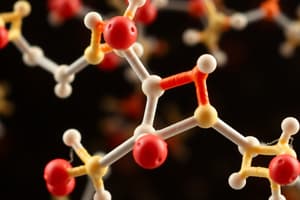Podcast
Questions and Answers
What distinguishes NADP from NAD in terms of their primary roles in metabolic processes?
What distinguishes NADP from NAD in terms of their primary roles in metabolic processes?
- NAD is primarily used in metabolic reactions, whereas NADP is used in biosynthetic pathways. (correct)
- NADP catalyzes more complex reactions than NAD does.
- NADP is involved in oxidative reactions, while NAD primarily supports reduction reactions.
- NAD is involved in biosynthetic pathways, while NADP is used in metabolic reactions.
During uncompetitive inhibition, what happens to both Vmax and Km?
During uncompetitive inhibition, what happens to both Vmax and Km?
- Vmax decreases while Km increases.
- Both Vmax and Km are decreased. (correct)
- There is no change in Vmax or Km.
- Vmax is increased while Km remains unchanged.
Which of the following statements about kinases is correct?
Which of the following statements about kinases is correct?
- They are a subclass of oxidoreductases.
- They transfer phosphate groups from GDP to substrates.
- They are exclusively responsible for transferring acetate groups.
- They typically transfer phosphate groups from ATP onto other molecules. (correct)
What is a key characteristic of enzymes that are classified as dehydrogenases?
What is a key characteristic of enzymes that are classified as dehydrogenases?
What is the immediate product when glucose is phosphorylated at C6 by hexokinase?
What is the immediate product when glucose is phosphorylated at C6 by hexokinase?
Which functional group transfer is NOT typically associated with transferases?
Which functional group transfer is NOT typically associated with transferases?
What happens to ATP during the reaction catalyzed by hexokinase?
What happens to ATP during the reaction catalyzed by hexokinase?
In terms of enzyme inhibition, how does competitive inhibition differ from uncompetitive inhibition?
In terms of enzyme inhibition, how does competitive inhibition differ from uncompetitive inhibition?
Which coenzyme is primarily associated with metabolic reactions?
Which coenzyme is primarily associated with metabolic reactions?
What type of reaction does hexokinase facilitate?
What type of reaction does hexokinase facilitate?
What is the primary functional group often involved in the phosphorylation process to activate enzymes?
What is the primary functional group often involved in the phosphorylation process to activate enzymes?
Which process describes the conversion of inactive enzyme precursors into active enzymes?
Which process describes the conversion of inactive enzyme precursors into active enzymes?
In the context of enzyme regulation, what is the role of ATP?
In the context of enzyme regulation, what is the role of ATP?
How does phosphorylation affect enzyme activity?
How does phosphorylation affect enzyme activity?
Which statement about enzyme synthesis is true?
Which statement about enzyme synthesis is true?
What role does ATP play in the context of enzyme regulation and energy?
What role does ATP play in the context of enzyme regulation and energy?
Which statement accurately describes feedback inhibition in enzyme regulation?
Which statement accurately describes feedback inhibition in enzyme regulation?
How does allosteric regulation differ from other forms of regulation?
How does allosteric regulation differ from other forms of regulation?
What happens when product E binds to an allosteric site on enzyme A?
What happens when product E binds to an allosteric site on enzyme A?
What characterizes integral proteins that function as enzymes when embedded in membranes?
What characterizes integral proteins that function as enzymes when embedded in membranes?
What is indicated by excessive amounts of the final product E in a metabolic pathway?
What is indicated by excessive amounts of the final product E in a metabolic pathway?
What is the effect of a positive modulator in allosteric regulation?
What is the effect of a positive modulator in allosteric regulation?
Covalent modification of enzymes typically involves which of the following?
Covalent modification of enzymes typically involves which of the following?
What describes the sequential transformation of substrates A to E in an enzymatic pathway?
What describes the sequential transformation of substrates A to E in an enzymatic pathway?
What is the primary composition of the cell membrane that facilitates enzyme activity?
What is the primary composition of the cell membrane that facilitates enzyme activity?
What is the primary characteristic of noncompetitive inhibition?
What is the primary characteristic of noncompetitive inhibition?
Which of the following statements about oxidoreductases is correct?
Which of the following statements about oxidoreductases is correct?
What distinguishes uncompetitive inhibition from other types of enzyme inhibition?
What distinguishes uncompetitive inhibition from other types of enzyme inhibition?
Which type of reaction is catalyzed by dehydrogenases?
Which type of reaction is catalyzed by dehydrogenases?
What happens to Vmax in the presence of a noncompetitive inhibitor?
What happens to Vmax in the presence of a noncompetitive inhibitor?
What is the role of enzyme-inhibitor complexes formed in noncompetitive inhibition?
What is the role of enzyme-inhibitor complexes formed in noncompetitive inhibition?
Which of the following enzymes is classified as an oxidoreductase?
Which of the following enzymes is classified as an oxidoreductase?
What is true about the binding sites of a noncompetitive inhibitor?
What is true about the binding sites of a noncompetitive inhibitor?
What is the primary function of phosphatases?
What is the primary function of phosphatases?
Which class of enzymes catalyzes reactions that involve the addition of water across bonds?
Which class of enzymes catalyzes reactions that involve the addition of water across bonds?
Isomers are defined as molecules that have what characteristic?
Isomers are defined as molecules that have what characteristic?
What distinguishes lyases from hydrolases?
What distinguishes lyases from hydrolases?
What is an example of an enzyme classified as a lyase?
What is an example of an enzyme classified as a lyase?
Which of the following statements about isomerases is correct?
Which of the following statements about isomerases is correct?
What is the role of the enzyme pyruvate decarboxylase?
What is the role of the enzyme pyruvate decarboxylase?
Fumarate and maleate are examples of what type of molecules?
Fumarate and maleate are examples of what type of molecules?
What type of reaction does a hydrolase enzyme primarily catalyze?
What type of reaction does a hydrolase enzyme primarily catalyze?
Which group of enzymes can generate rings or double bonds while breaking bonds?
Which group of enzymes can generate rings or double bonds while breaking bonds?
Flashcards are hidden until you start studying
Study Notes
Noncompetitive Inhibition
- Involves the inhibitor binding to an allosteric site rather than the active site.
- Substrate can still bind to the active site, but enzyme activity is reduced.
- Both enzyme-inhibitor (EI) and enzyme-inhibitor-substrate (EIS) complexes can be enzymatically active.
- Vmax decreases without affecting Km.
Uncompetitive Inhibition
- Inhibitor binds exclusively to the enzyme-substrate complex (ES), forming EIS.
- Both Vmax and Km are reduced.
- Results in higher affinity for substrate but slower reaction rate.
Oxidoreductases
- Catalyze redox reactions, facilitating electron transfer between molecules.
- Commonly identified by suffix "-ase" (e.g., hexokinase).
- Subclass of oxidoreductases known as dehydrogenases, which use coenzymes like NAD, FAD, or NADP.
- NAD is primarily for metabolic reactions, while NADP is for biosynthetic pathways.
Transferases
- Enzymes that transfer functional groups, such as methyl or phosphate groups.
- Kinases are a key subclass that specifically transfer phosphate groups, typically from ATP to substrates (e.g., hexokinase phosphorylating glucose).
Hydrolases
- Enzymes that catalyze hydrolytic reactions, adding water to break chemical bonds (e.g., glucose to fructose).
- Hydrolysis involves the addition of water to cleave bonds.
Isomerases
- Catalyze the transformation between isomers, molecules with the same structure but different configurations.
- Example: Interconversion of fumarate and maleate.
Lyases
- Enzymes that break chemical bonds without the addition of water.
- Can generate double bonds or rings during reactions (e.g., pyruvate decarboxylase).
Allosteric Regulation
- Enzymes can be activated or inhibited by molecules binding to allosteric sites.
- Feedback inhibition occurs when a final product binds to an enzyme early in the pathway, slowing the reaction.
- Precursor activation can also take place, where substrate binding activates the enzyme.
Covalent Modification
- Involves attaching a functional group (e.g., phosphate) to an enzyme, which can change its activity.
- Phosphorylation, often sourced from ATP, can activate or inhibit enzymes depending on the metabolic context.
Regulation of Enzyme Synthesis
- Enzyme levels are controlled by regulating gene expression.
- Enzymes are proteins synthesized through transcription and translation processes guided by DNA.
Studying That Suits You
Use AI to generate personalized quizzes and flashcards to suit your learning preferences.




